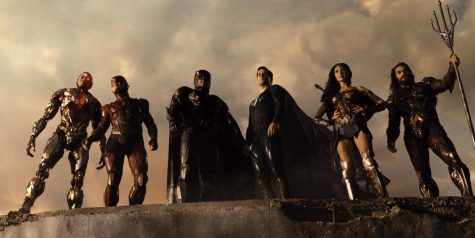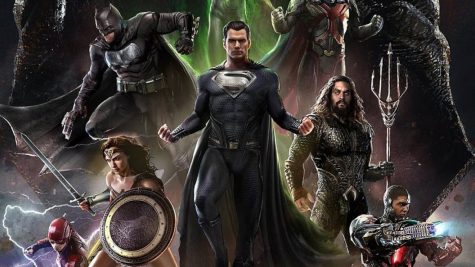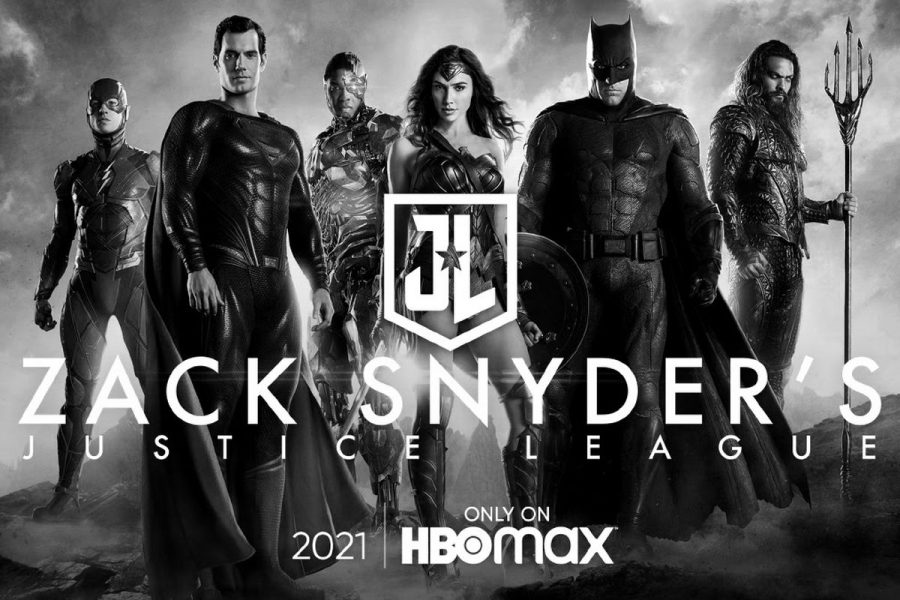What Is the Snyder Cut?
In 2017, the much-awaited Justice League was released. After years of large-scale world-building from its predecessors, production disruptions, and entire creative overhauls, the film was finally released. And it was terrible. Like really bad.
With a Rotten Tomato score polling at 40% and a Metacritic percentage leveling at 45%, 2017’s Justice League was not only a critical failure but a film that failed to fulfill any audience member’s hopes for an enjoyable film. Instead, pretentious critics, dedicated fans, and casual viewers were treated with 120 minutes of lazy writing, sub-par action fights muddled in CGI, and lackluster performances stuffed into a B-list superhero film laden with plot holes. So, for a film that had so much hype and anticipation, what happened? What went wrong with DC’s failed attempt at an Avengers equivalent? And, more importantly, why did another Justice League film just get released last week?
In 2009, Zack Snyder, a relatively up-and-coming filmmaker who has just enjoyed immense success after adapting Frank Miller’s 300 with Gerard Butler (think: “This is Sparta!”), helms a film based on the notoriously grim and complex graphic novel Watchmen. This three-and-a-half-hour epic marks Snyder’s first excursion into the DC Universe: a developing cinematic world filled with creative possibilities and complete uncertainties. Snyder’s vision for a superhero universe is an attempt to break away from the Marvel Cinematic Universe’s (MCU) optimistic, humorous, and unmistakably “PG-13” tone that defined blockbusters like Iron Man, Captain America, and The Avengers. In other words, while the MCU mixed family-friendly jokes with commonplace explosions, Snyder was hoping to redefine the superhero genre with his signature “Snyder-isms,” like slow-motion, gratuitous action scenes, and–quite possibly–too much CGI.
Finally, in 2013, Snyder takes his first step, of many, for a new superhero universe with Superman’s origin film Man of Steel, which was marked with mixed critical and fan reviews. While some fans adored the director’s use of time-jumps, slow-motion, and darkly realistic tones, many believed that his work was an overly serious and overcomplicated mess that failed to do the final Kryptonian any justice. However, these reviews were not circumstantial enough to stop Snyder’s momentum, or Warner Brothers’ confidence in him, to continue to explore his creative endeavors in the superhero genre. After years of development, Snyder made yet another leap into his newly defined superhero genre with 2016’s Batman v Superman: Dawn of Justice (yes, that is the actual title). With even more slow-motion, more CGI, and even less happiness, BvS–as it’s called–pushed even further into Snyder’s vision for a grisly take on superhero films, leading to some of the worst critical and fan reviews for a film of this size. Although Snyder actively pursued his creative intentions, his efforts on BvS resulted in lifeless action scenes, mediocre acting, and a disappointing ending, throwing the future of his vision in jeopardy. And yet, even after terrible audience and critic reviews (29% on Rotten Tomatoes!), Snyder was given one more chance to fulfill the vision he had for his grim, muted superhero universe: Justice League.
 However, during the production of Snyder’s grand unification of the menacing universe he once envisioned, his hopes for an intricately assembled DC Extended Universe, and parts of his personal life, were shattered. Months into filming, after Snyder had already begun ingraining the dark tone he had for his film, Warner Brothers finally began to realize what they had to do to create commercially and critically successful superhero films, similar to their overwhelmingly triumphant Marvel counterparts: stop the “Snyder-isms.” Envying the success of Kevin Feige’s MCU, the studio wanted to have the family-friendly jokes and “PG-13” behavior that led to satisfied fans and box-office records. But Snyder, halfway through the film that could possibly change the superhero genre for years to come, constantly refused the studio’s pleas to redefine his foreboding superhero universe into an optimistic beacon within a market-friendly franchise. And then, among the growing creative tension guaranteed between any studio and filmmaker, the real world threw everything upside-down when Zack Snyder’s daughter Autumn committed suicide.
However, during the production of Snyder’s grand unification of the menacing universe he once envisioned, his hopes for an intricately assembled DC Extended Universe, and parts of his personal life, were shattered. Months into filming, after Snyder had already begun ingraining the dark tone he had for his film, Warner Brothers finally began to realize what they had to do to create commercially and critically successful superhero films, similar to their overwhelmingly triumphant Marvel counterparts: stop the “Snyder-isms.” Envying the success of Kevin Feige’s MCU, the studio wanted to have the family-friendly jokes and “PG-13” behavior that led to satisfied fans and box-office records. But Snyder, halfway through the film that could possibly change the superhero genre for years to come, constantly refused the studio’s pleas to redefine his foreboding superhero universe into an optimistic beacon within a market-friendly franchise. And then, among the growing creative tension guaranteed between any studio and filmmaker, the real world threw everything upside-down when Zack Snyder’s daughter Autumn committed suicide.
Struggling with depression and addiction for many years, Autumn Snyder took her own life in March 2017, leading Snyder to abandon his career-defining epic and the superhero universe he struggled to cultivate for years. Struck with the sudden shock of his child’s death, Snyder left Justice League, taking time away from the now-superficial worries of the film industry, to help raise awareness for suicide through the American Foundation for Suicide Prevention (AFSP).
Now, without their visionary director at the helm, Warner Brothers was left with nearly an entire film already shot in Snyder’s grim, slow-motion vision. However, the studio saw Snyder’s leave as an opportunity to achieve the bright tone defined by the commercially successful superhero films of blockbusters past and to bleach their property of any remaining “Snyder-isms.” In a subtle effort to emulate the triumph of the commercially and critically successful The Avengers from the MCU, the studio hired the one man responsible for that exact success: Joss Whedon. Known for assembling the Avengers in 2012, Whedon went on to direct the sequel to the blockbuster hit only to leave the MCU altogether after–you guessed it–creative differences. (Slight tangent, but it’s worth mentioning that, in an ironic twist of fate, Whedon has become particularly known for his refusal to cooperate with studios, which often result in the vaguely-named scapegoat known as “creative differences.”) In other words, Whedon quit his efforts with the MCU because of the exact same reason that Snyder has been fighting against for years: the right to execute one’s vision.
When Whedon took over the remains of Snyder’s nearly-complete Justice League, he was faced with the gargantuan task of eliminating any “Snyder-isms,” brightening up the tone and recreating the film to better fit the mold of an easily-digestible superhero blockbuster. So, essentially, Whedon took up this task by reshooting almost the entire script, like family-friendly action scenes, character-driven conversations, and even removing major plot points which tied the original film together. One of the many ridiculous additions from Whedon’s rewrites includes a scene introducing the film’s major conflict to Batman as he captures a cat burglar on a moonlit rooftop. While this may sound like a basic enough set-up, the reality actually includes a Kindergarten-like production set, a poorly directed action scene, and an unmasked, unrealistic burglar (who, interestingly enough, was played by a very talented actor) offering misplaced humor, resulting in a cartoonish scene that brought only shame to Snyder’s name. Another, and possibly the most important, example of Whedon’s failures to restructure Snyder’s vision is the opening scene where Superman is asked questions by young fans through a phone-camera. Again, this may sound like a simple–even creative–opening, however, Superman’s face was completely distorted due to botched CGI in an effort to hide Henry Cavill’s mustache. That’s right: one of the biggest failures of Whedon’s career came down to some facial hair. Now, years after the confusing, disorganized, and incoherent production of Justice League, Ray Fisher, who plays Cyborg, claims that Whedon publicly abused cast members on-set in order to meet production goals in time for the studio’s release date. Yikes.
Whedon’s sad attempt to adapt Snyder’s vision to an MCU equivalent was finally released in late 2017, following months of rushed performances, poor direction, and child-like editing, only to be met with extreme dissatisfaction from critics and pure disgust from audiences. The major problem with Whedon’s failed venture was his inability to mold Snyder’s developed, grim universe into a lighter, family-friendly blockbuster, unfortunately shaped by forced performances, ridiculous plot holes, and–worst of all–tortuous jokes. Although BvS received a lower Rotten Tomatoes score, I personally believe that Whedon’s Justice League is the single worst experience anyone will ever have in human existence.
Since Justice League’s opening in late 2017, Warner Brothers has begun to place a greater emphasis on more optimistic, humorous, and family-friendly formulas for their DC films, ridding the world of Snyder’s vision of an unorthodox superhero universe. This emphasis has greatly influenced some of the following DC films, leading to exactly what the studio envied from their MCU counterparts: positive feedback from audiences and critics alike. For instance, Aquaman, released over a year after Justice League, was filled with bright colors and humor, ushering in one of the most successful box-office runs in history (even joining the prestigious “billion-dollar club”) and receiving a modest 65% on Rotten Tomatoes. Similarly, Shazam! (2019), Birds of Prey (2020), and Wonder Woman: 1984 (2020) have heavily utilized humor and optimism, leading to successful blockbusters, very similar to the MCU, but usually mixed reviews, unlike the MCU. In other words, as the studio began to alter their superhero universe into a cookie-cutter, box-office friendly, and–ultimately–forgettable experience, they have sacrificed the opportunity to create a world unique from Marvel’s already well-established franchise.
Which brings us to the Snyder Cut. In the weeks following the release of Whedon’s disastrously pathetic excuse for a film, fans began to realize that Snyder’s original cut of the film, complete with muted colors, slow-motion scenes, and excessive CGI, may be hidden in the surreptitious depths of Warner Brothers’ archives, leading millions to create an online movement in support of Snyder’s vision: #ReleasetheSnyderCut. Although there have been many fan-based efforts to view a films’ original cut in the past, this movement was extremely different in many ways. For example, unlike many previous fan-based efforts to view a films’ original cut, #ReleasetheSnyderCut raised money for suicide prevention in association with the AFSP in order to bring awareness to the death of Snyder’s daughter. In fact, according to the AFSP, fans were able to raise over half a million dollars for this incredibly important effort, establishing the online movement’s validity to those who might have seen it as a lost cause. Additionally, years after the release of the dreadful theatrical cut, Snyder himself broke his media silence by supporting #ReleasetheSnyderCut, leading to Ben Affleck, Gal Gadot, and other stars of the film to support the original cut, further legitimizing the global effort.
 Finally, years after the film’s release, Warner Brothers launched HBO Max, a streaming service filled to the brim with properties under the WB domain, including the half-Snyder, half-formulaic combination now known as the DC Extended Universe. With the continuous growth and legitimization of #ReleasetheSnyderCut, the studio–much like after Snyder’s departure from Justice League–saw an opportunity to make itself more profitable. In order to satisfy fans’ demands, and, more importantly, advertise their brand new streaming service, Warner Brothers decided to give Zack Snyder the chance to finally show the world what it had desperately sought for over three years: his original vision for Justice League. With a $70 million budget to complete post-production, Snyder finally had the opportunity to bring his dreams for a united front of gritty, realistic superheroes to life–possibly the same dream that began when he released Man of Steel eight years ago.
Finally, years after the film’s release, Warner Brothers launched HBO Max, a streaming service filled to the brim with properties under the WB domain, including the half-Snyder, half-formulaic combination now known as the DC Extended Universe. With the continuous growth and legitimization of #ReleasetheSnyderCut, the studio–much like after Snyder’s departure from Justice League–saw an opportunity to make itself more profitable. In order to satisfy fans’ demands, and, more importantly, advertise their brand new streaming service, Warner Brothers decided to give Zack Snyder the chance to finally show the world what it had desperately sought for over three years: his original vision for Justice League. With a $70 million budget to complete post-production, Snyder finally had the opportunity to bring his dreams for a united front of gritty, realistic superheroes to life–possibly the same dream that began when he released Man of Steel eight years ago.
With the film already shot, Snyder completed his film by reinstating its distinct muted colors, unique graphic violence, a brooding score composed by JunkieXL, a brand-new 1.33:1 aspect ratio, scenes that continue to expand Snyder’s superhero universe, and, of course, the quintessential “Snyder-ism”: slow-motion. Released on HBO Max–for all subscribers to view from the comfort of their homes–on March 18, 2021, Zack Snyder’s Justice League gave fans exactly what they ached for, ever since the abominable theatrical cut entered their lives. Although many critics panned the film, the much-awaited Snyder Cut earned 73% on Rotten Tomatoes and an average of 54% on Metacritic, however, most fans absolutely adored every second of the film.
Along with the many unique excitements that come with any Zack Snyder film, and there are many, comes a trail of weaknesses, including its gargantuan 242-minute runtime (that’s over 4 hours for you math majors out there), a ridiculous reliance on CGI (apparently over 2000 VFX shots in the entire film), and a desperate rush into world-building, despite its lack of the proper infrastructure laid out over multiple films. For many, the runtime is a complete turn-off, especially considering the film runs along the same plotlines as its theatrical predecessor.
However, while it’s important to note that the Snyder Cut is an over-the-top, often slow yet rushed, and hedonistic experience, it’s even more important to establish that the Snyder Cut, for all its weaknesses, lived up to every second the fans waited for. To truly enjoy the four hours of fight scenes, alien invasions, and superhero imagery, it might be essential for viewers to grasp the complete story behind such a cultural event. An event, by the way, that was propelled by the desires of fans, eventually forcing a studio to give them exactly what they wanted. The Snyder Cut, in all its glory, is a beautiful mess filled with untapped possibilities that may never have the chance of being explored. Nevertheless, it’s an opportunity for fans to witness the power of Zack Snyder’s–and their own–dedication and unbridled passion for a project that truly meant the world to them.

Hashim Latif is a senior and a lifer at Keystone and he's extremely passionate about entertainment and culture in our world today. He wishes to work in...

